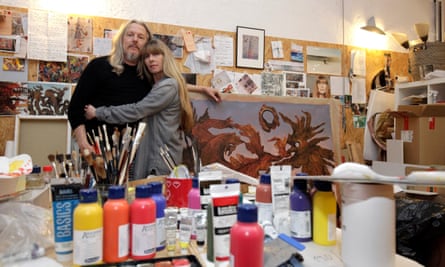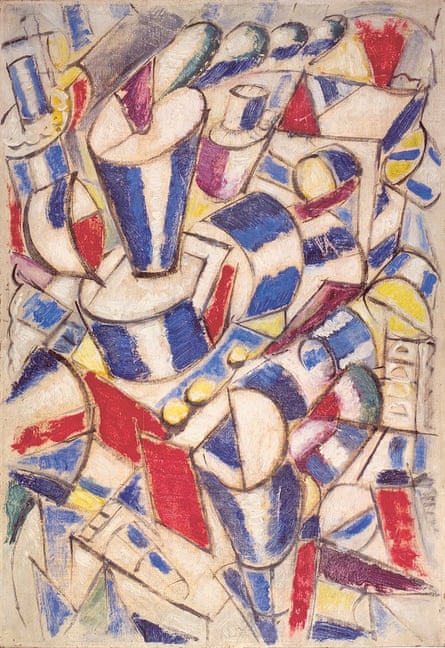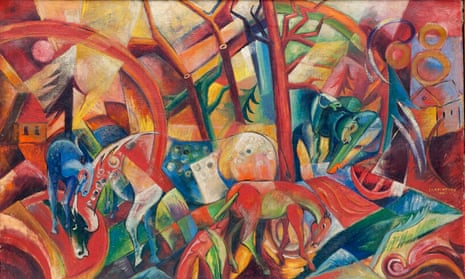Their forgeries of 20th-century masters such as Max Ernst and Fernand Léger duped the art world into parting with millions of pounds – until a modern pigment gave them away.
Now, after serving lengthy prison sentences, Wolfgang Beltracchi and his wife Helene have told the story behind the hundreds of paintings that tricked even the artists’ families.
In interviews with Jeannette Fischer, a Zurich-based psychoanalyst and author, the couple described their motivation for fooling what they believed was a “fraudulent” art world.
Wolfgang said he had never forged pictures with compositions that would unnerve the onlooker. “I have to create something beautiful … I want to make people happy,” he said.
He described forgery as “almost incidental”: “We enjoyed selling the paintings. We got a kick out of it. We got rich,” he said. “I got to paint, and we enjoyed doing the research too. Forgery was a way of combining all these things. And I got to sit around the pool for days, reading and daydreaming and sleeping.”
Helene added: “The more successful we were in selling the pictures, the higher we set the bar and the more extra stories we came up with, because we were really enjoying this game. Sometimes we laid trails so elaborate that nobody would ever have discovered them.”

She recalled approaching an auction-house expert with a forged painting by Georges Valmier, the French artist and early cubist. “I was pretty nervous. What if she rejected [it]? We made up a story to explain the provenance of the picture. I was amazed at how easy the whole thing was. My heart was in my mouth – but I got a kick out of it, too. The painting was put up for auction as ‘the most important work of the period of synthetic cubism’.”
Such was their success that, when they sold one of their Ernst forgeries to a collector for $7m, they learned the artist’s widow had described it as as one of his best forest pictures. They received almost €2m for a forged painting by André Derain, which a London gallery sold for more than $6m.
Fischer’s research will appear in a forthcoming book, Psychoanalyst Meets Helene and Wolfgang Beltracchi, to be published this spring.
Observing that “the Beltracchis see the art market itself as a fraudulent business”, she writes: “In their view, they were cheating those who made a living by cheating others.”

Beltracchi was born as Wolfgang Fischer in Hoxter, Germany, in 1951 and learned his craft by helping his father restore paintings in churches. Aged 12, he copied a Picasso. By the time he met Helene, he had been forging paintings for 20 years – when they fell in love, he confessed his secret and they became partners in crime and married in 1993, taking her surname.
His talent extended to imitating numerous artists, including Heinrich Campendonk, the German expressionist, and André Derain, the French fauvist. Forged labels from galleries or collections heightened the authenticity. The Beltracchis spent months researching the artist’s life, creating paintings that related to “lost” works or “gaps” in their oeuvre.
Wolfgang said: “Ernst was a very typical example. He always painted series, always in a specific way. In one series, for example, he painted crowds, and in the next forests. So what was missing was a painting featuring crowds and forests together. A transition picture, you might say. And that’s the picture I painted.”
He spoke of having a “physical reaction” to paintings. “I read the handwriting by seeing and feeling every movement of his body, reading his state of mind from the brushstrokes, because handwriting is made up of movement and time.”
Helene explained that they travelled to the places where such pictures were painted and at the same time of year. “When you’re actually there, you can really feel what it was like and you can imagine how the painter stood or sat or lived and which influences he was exposed to.”
The couple recalled laying a “brilliant trail” in faking a photograph of a still life exhibition that was held in Berlin in 1924 to give the impression that their forged Léger painting had been on its walls.
Beltracchi said: “The exhibition really happened, but there were no photos of it – and of course my forged picture wasn’t really there.”
For him, “the cherry on the cake” was a note he had forged between the gallery’s deceased former owner and a collector known to have bought from him. The owner’s son identified his father’s signature “straight away”.
Fischer writes: “The fact that everything had always gone so smoothly may have made Wolfgang Beltracchi a little careless. For his last picture, he used the wrong white. That was the beginning of the end of the Beltracchis’ career as forgers.”
In 2008, analysis of their forged Campendonk painting – Rotes Bild mit Pferden (Red Picture with Horses), which had sold for a record price of €2.8m in 2006 – revealed traces of titanium white, a pigment that was not used by the supposed painter in 1914. Beltracchi had run out of zinc, which he used to mix with his white colour himself, and he bought a pure zinc white from a Dutch manufacturer that did not disclose that the paint contained traces of titanium white.
That was his “fatal error”. It sparked a police investigation. Panic spread through the art world and, in 2011, a German court sentenced Wolfgang and Helene to six and four years respectively.
Asked what most surprised her about the couple, Fischer said: “That they bought liberty and free time with the money they organised for themselves through the scam. No Ferrari, no Prada dresses, but free space to go to museums, to look after the children, to pursue their passion for research.”
